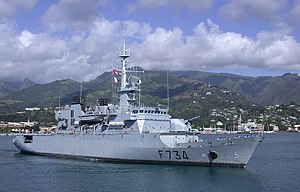Floréal-class frigate

Frigate Vendémiaire of the French Navy
|
|
| Class overview | |
|---|---|
| Name: | Floréal class |
| Builders: | Chantiers de l'Atlantique, Saint-Nazaire |
| Operators: | |
| Preceded by: | D'Estienne d'Orves class |
| In commission: | 27 May 1992 |
| Completed: |
|
| Active: | |
| General characteristics | |
| Type: | Frigate |
| Displacement: |
|
| Length: | 93.5 m (307 ft) |
| Beam: | 14 m (46 ft) |
| Draught: | 4.3 m (14 ft) |
| Propulsion: |
|
| Speed: | 20 kn (37 km/h; 23 mph) |
| Range: | 10,000 nmi (19,000 km; 12,000 mi) at 15 kn (28 km/h; 17 mph), 13,000 nmi (24,000 km; 15,000 mi) at 12 kn (22 km/h; 14 mph) |
| Complement: |
|
| Sensors and processing systems: |
|
| Electronic warfare & decoys: |
|
| Armament: |
|
| Aircraft carried: | 1 × Panther anti-submarine helicopter |
The Floréal class is a type of light "surveillance frigates" designed for the needs of the French Navy after the end of the Cold War, ordered in 1989. They use construction standards of commercial ships. The ships are named after months of the Republican Calendar.
After the end of the Cold War, it was felt that the risks of a large-scale military confrontation had all but disappeared. The Marine Nationale had to face new missions, while its escort avisos from the 1980s were ageing, and also badly adapted to low-risk zones.
The concept of "sentry frigate" emerged from the will of the French government to protect its Exclusive Economic Zone (12 million km²), as defined in the Montego Bay treaties. Another need was to address matters of humanitarian aid, diplomacy, or naval law enforcement. To address these missions, an onboard helicopter is clearly the optimal solution, providing versatile, swift and long-range capabilities to deliver support, ferry or rescue.
These constraints defined the need for a ship which would be small; extremely stable to allow use of a heavy helicopter in all weather; small crew, while retaining capacities to accommodate navy commandos; light armament; economic and long-range propulsion system.
In keeping with the requirements, all the ships save one are based overseas in French territories. Prairial is based at Papeete, Tahiti; Floréal and Nivôse at La Reunion; Vendémiare at Noumea; Ventôse at Fort de France, Martinique, French Antilles. Germinal is based at Toulon, France.
To make the ship more economical, civilian construction methods were used at the Chantiers de l'Atlantique in Saint Nazaire. The ships use the SOLAS (Safety Of Life At Sea) regulations, which require the hull to have eleven watertight compartments. The rules of the classification society Det Norske Veritas are used for energy production and safety. The ships were built in series, each with six pre-fabricated parts weighing up to 570 tonnes that were assembled and welded in a dry dock. (The construction method was later used for the La Fayette class). The first trials at sea were carried out in 1991 with an entirely civilian crew, while the Marine Nationale was only present as an observer.
...
Wikipedia
